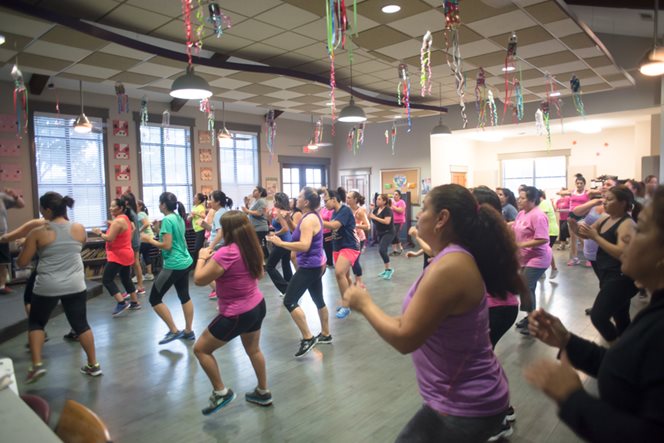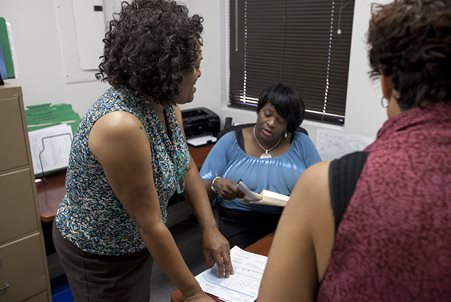In NeighborWorks America’s new, five-year strategic plan (2017-2021), one of the most significant transitions in our direction is our recognition that many members of our network are increasingly broadening and deepening their cross-sector collaborations. We want to support them in advancing this new paradigm to create more opportunities for low-income people and communities.
| Healthy homes | 89% |
| Healthy food access | 57% |
| Community engagement | 55% |
| Environment | 52% |
| Financial | 50% |
| Physical activity | 46% |
| Community design | 42% |
A paper summarizing the results of the survey, co-authored by NeighborWorks’ Director of Healthy Homes and Communities Sarah Norman, now is in peer review at the journal Cities & Health and is summarized in a blog post on the website of Harvard’s Joint Center for Housing Studies.
“What makes these findings striking is the message they send to the nation’s health providers, who are called upon by recent changes in the medical field to pay more attention to the social determinants of health—including housing,” says Norman. “Rather than strike out on their own, we urge health stakeholders to partner with housing and community-development organizations already working in neighborhoods across the country.”
Tips for finding health partners
According to the County Health Rankings and Roadmaps Program, about 80 percent of a person’s health status can be attributed to non-medical factors such as housing and income. This is increasingly acknowledged and in fact, current law requires nonprofit hospitals to think beyond medical care to community health.
However, don’t expect health-care providers to reach out to you. It is up to you to proactively contact hospitals, county departments of public health, etc. Here are some useful facts and suggestions for housing and communityi-development organizations wanting to get started in this space or seek other allies in the health sector:
- Consider: Are you large enough to be attractive to a health-care provider? The economics of care delivery mean a provider must cater to a large volume of potential patients to make services economically feasible. If your properties are small, consider creating a local network of properties interested in a housing-health partnership.

- Map the health-care providers in your area. Be sure to know which providers your residents use and who pays for them. Go deeper than that, however: Know your residents’ needs, ideally through an assessment of their health, functional status and service needs. One example of such an assessment is available on the LeadingAge website.
- Determine who is in charge of defining and monitoring community benefits at your local hospital. If there is not a specific community benefits department, the responsibility often is delegated to individuals in finance or marketing. You may have to knock on several wrong doors before finding the right one. And don’t hesitate to use any connections your staff or board members have.
- Before you call, become familiar with the legal requirements imposed on hospitals and the language used. A primer on community-benefit requirements is offered by St. Luke’s Health Initiatives. Also do some research and find the hospital’s community health needs assessment (CHNA) and Schedule H (part of its 990 IRS form). The CHNA defines how a hospital views the community it serves and the challenges residents face. The activities carried out to date are outlined in the Schedule H. (Note that hospitals are required to make both documents public; CHNAs are typically posted on their websites and the primer listed above outlines how to find the Schedule H.) The staff responsible for publishing the CHNA are responsible for building community relationships as well, so don't hesitate to reach out to them directly.
- The key is to link a health-care provider’s medical challenges to your programs and look for win-win opportunities. For example, if a hospital has identified diabetes as a significant challenge, discuss how you use farmers markets or a garden-to-table class to increase access to healthy food and encourage better eating.
- A particularly fruitful area for collaboration may be managing high-risk, low-income older adults, of which there are about 2 million living in affordable senior housing. Due to their advanced age and other demographics, many are coping with multiple chronic illnesses and/or functional impairments, putting them at risk of emergency-room visits, hospitalizations and other costly medical services. A partnership with housing providers can help health-care providers intervene earlier and manage chronic problems more effectively.
- Don’t expect immediate results. Cultivating new relationships takes time, so have the long game in mind.
Case studies from the NeighborWorks book
Housing and health care nonprofits work together to achieve affordable, home-based care: Many
Unlikely partners: collective impact: Chicanos Por La Causa partnered with UnitedHealthcare Community and State to create the myCommunity Connect Center in Phoenix—a one-stop location for a broad range of health and social services. Clients meet with a community health worker for a complete needs assessment and an individualized care plan is developed.
Health and housing: a vital collaboration: Westside Housing Organization joined with the Kansas City Health Department and Children’s Mercy Hospital to reduce illness and injury from household hazards. Hospital staff trained Westside employees to conduct healthy home assessments, and the city health department provide funding for urban gardening and other projects.
Healthy homes–healthy residents: Two impact studies were conducted by Southwest Minnesota Housing Partnership—before and after it partnered with a variety of others to respiratory health for children and adults in its properties. Partners included the Blue Cross Blue Shield of Minnesota Foundation and the National Center for Healthy Housing. Improvements centered on such features as ventilation, moisture and mold reduction.
Improving housing and health for underserved residents: Foundation Communities partnered with the City of Austin’s Health and Human Services Department and others to form a corps of “health champions” to organize exercise, nutrition and other health classes for its residents. Improvements in health outcomes and cost savings were highlighted in the working paper published jointly by NeighborWorks America and the Joint Center for Housing Studies of Harvard University.

